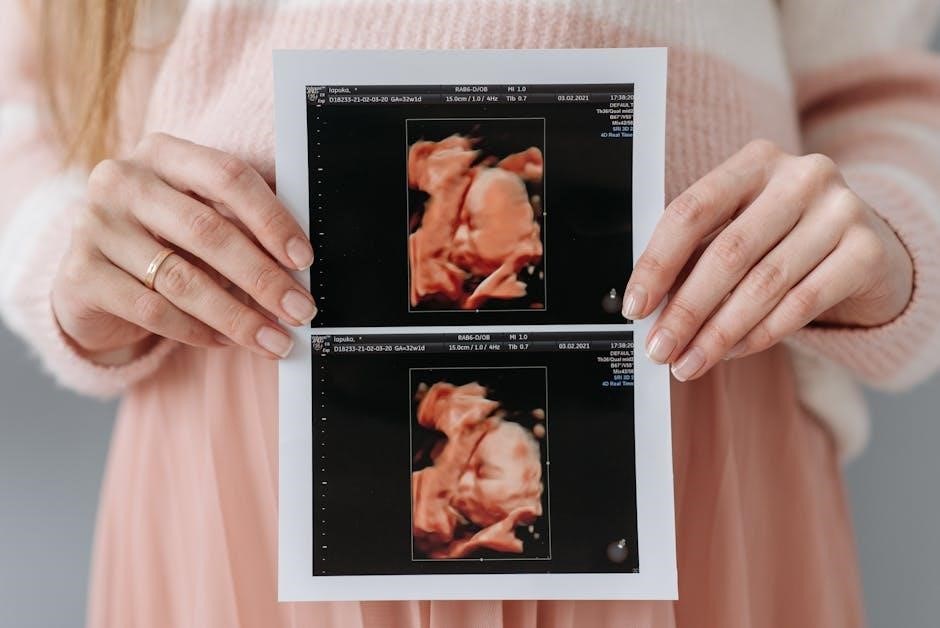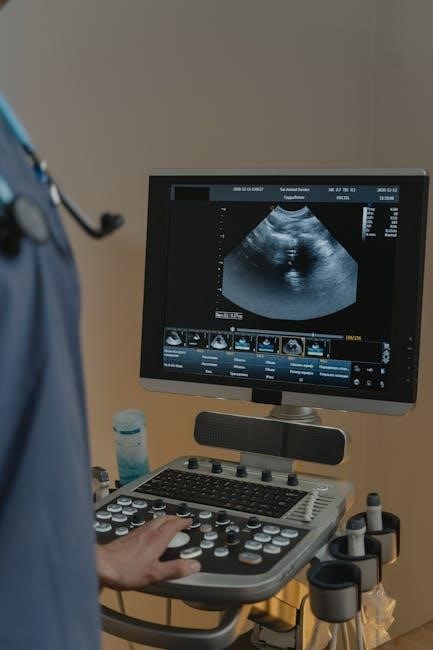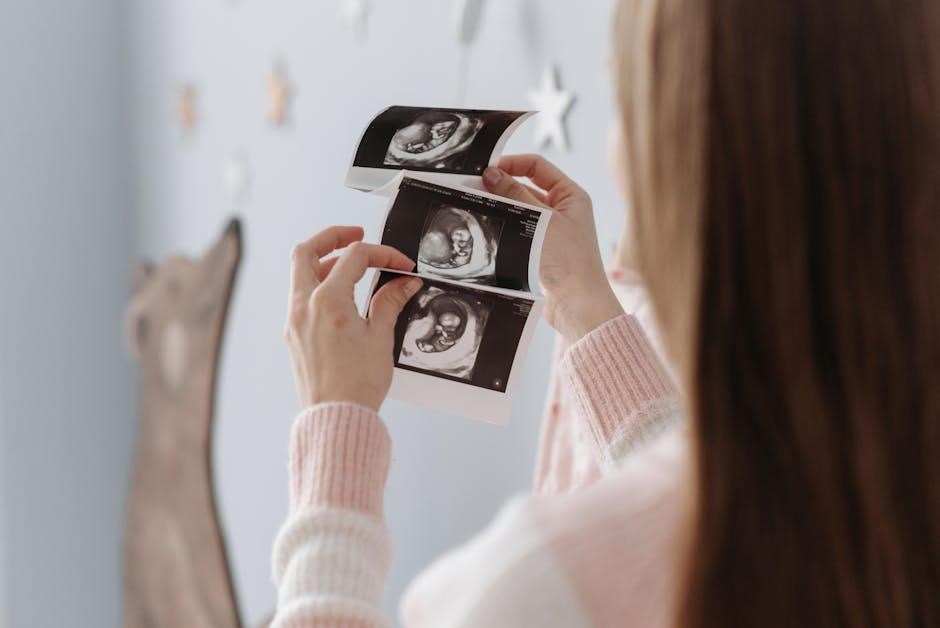CPT codes are essential for accurate billing of thyroid ultrasound-guided biopsies, ensuring proper reimbursement and documentation; Codes like 76536, 76942, and 10005-10012 specifically address ultrasound guidance, fine needle aspirations, and tissue sampling procedures.
Overview of Thyroid Ultrasound-Guided Biopsy
Thyroid ultrasound-guided biopsy is a minimally invasive procedure that uses ultrasound imaging to guide the insertion of a needle into thyroid nodules for tissue sampling. This technique ensures precise targeting of suspicious areas, reducing the risk of complications. The procedure is typically performed under local anesthesia and is well-tolerated by patients. Ultrasound guidance enhances the accuracy of needle placement, making it a preferred method for diagnosing thyroid nodules. Fine needle aspiration (FNA) is the most common type of biopsy, while core needle biopsy (CNB) may be used for larger or suspicious lesions. The use of ultrasound allows for real-time visualization, improving diagnostic yield and patient outcomes. Accurate coding of this procedure is critical for proper reimbursement and documentation, with specific CPT codes addressing the ultrasound guidance and biopsy components.
Importance of Accurate CPT Coding
Accurate CPT coding for thyroid ultrasound-guided biopsies is crucial for proper reimbursement, compliance, and documentation. Incorrect or outdated codes can lead to denied claims, delayed payments, or audits. Specific codes like 76536 (ultrasound of soft tissues) and 76942 (ultrasonic guidance) must be used to reflect the procedure accurately. Additionally, codes 10005-10012 are essential for image-guided fine needle aspirations, varying by the number of lesions. Proper coding ensures that both the ultrasound guidance and biopsy components are billed correctly. It also avoids reimbursement issues and maintains compliance with payer policies. Staying updated with CPT code changes, such as the replacement of outdated codes like 10022, is vital for avoiding errors and ensuring seamless billing processes. Accurate coding protects healthcare providers from financial losses and administrative burdens, ensuring efficient patient care and revenue cycle management.

CPT Codes for Thyroid Biopsy Procedures
Key CPT codes for thyroid biopsy include 76536 (ultrasound of soft tissues), 76942 (ultrasonic guidance), and 10005-10012 (image-guided fine needle aspirations).
- 76536: Ultrasound imaging of head and neck soft tissues.
- 76942: Guidance for needle placement during biopsy.
- 10005-10012: Codes for fine needle aspirations based on the number of lesions.
CPT Code 76536: Ultrasound of Soft Tissues of the Head and Neck
CPT code 76536 is used for ultrasound imaging of soft tissues in the head and neck region, including the thyroid gland. This code is essential for evaluating thyroid nodules or masses and is often a precursor to biopsy procedures. It involves the use of ultrasound technology to produce detailed images of the soft tissues, aiding in the identification of abnormalities such as nodules, cysts, or enlarged lymph nodes. 76536 is commonly billed alongside other codes, such as 76942, when ultrasound guidance is used for needle placement during a biopsy. Proper documentation of the procedure and findings is crucial for accurate billing and reimbursement.
- Covers ultrasound imaging of soft tissues in the head and neck.
- Used for evaluating thyroid nodules or masses.
- Often paired with 76942 for guided biopsies.
CPT Code 76942: Ultrasonic Guidance for Needle Placement
CPT code 76942 is specifically used for ultrasonic guidance during needle placement, such as in thyroid biopsy procedures. This code covers the imaging supervision and interpretation required to accurately guide the needle to the target area. It is essential for ensuring precise placement during fine needle aspirations or core biopsies. 76942 is often billed alongside other codes, such as 60100 for percutaneous needle core biopsy or 10005-10012 for image-guided fine needle aspiration biopsies. Proper documentation of the ultrasonic guidance is crucial for accurate billing and reimbursement. This code reflects the technical component of the procedure, emphasizing the importance of real-time ultrasound imaging during biopsy.
- Covers ultrasonic guidance for needle placement during biopsy.
- Includes imaging supervision and interpretation.
- Commonly paired with biopsy-specific codes like 60100 or 10005-10012.
CPT Codes 10005-10012: Image-Guided Fine Needle Aspiration Biopsies
CPT codes 10005-10012 are designated for image-guided fine needle aspiration (FNA) biopsies, including those of the thyroid. These codes replaced the outdated 10022 code in 2019, providing a more detailed and specific coding system. 10005 is used for the first lesion, while 10006 applies to each additional lesion biopsied during the same session. This distinction ensures accurate billing for multiple nodules or sites. Proper documentation is crucial, as these codes require clear identification of each biopsy site and the imaging modality used. This change enhances coding precision and reflects the complexity of modern biopsy procedures, ensuring appropriate reimbursement for healthcare providers.
- 10005: First lesion FNA biopsy.
- 10006: Each additional lesion FNA biopsy.
- Requires detailed documentation of biopsy sites.

When to Use Specific CPT Codes
Specific CPT codes are selected based on the procedure’s nature and complexity. Use 76536 for head and neck ultrasound imaging, 76942 for ultrasonic guidance during biopsy, and 10005-10012 for image-guided FNAs. Choose 60100 for core biopsies and 76537 for thyroid-focused ultrasounds. Ensure accurate documentation and adhere to payer policies for proper reimbursement.
Using CPT Code 60100 for Percutaneous Needle Core Biopsy
CPT code 60100 is specifically used for percutaneous needle core biopsies of the thyroid gland. This code applies when a core biopsy is performed, requiring a larger tissue sample compared to fine needle aspiration. It is essential to use this code when the procedure involves a core needle, as it distinguishes from fine needle aspiration biopsies. The code does not include imaging guidance, so if ultrasound guidance is used, an additional code such as 76942 must be reported. Proper documentation is critical, including the method of biopsy, needle size, and target lesion description. Ensure compliance with payer policies and guidelines to avoid reimbursement issues. This code is appropriate when a core biopsy is medically necessary for diagnostic purposes, providing detailed tissue architecture for pathology evaluation.
Appropriate Use of CPT Code 76537 for Thyroid and Parathyroid Glands
CPT code 76537 is specifically designed for ultrasound examinations of the thyroid and parathyroid glands. This code is used when the physician evaluates these glands directly, excluding other soft tissues of the head and neck. It is essential to use this code only when the procedure focuses solely on the thyroid and parathyroid glands, as it is a limited code. Documentation must clearly indicate the target areas to justify its use. For example, if a thyroid nodule or parathyroid lesion is being evaluated, 76537 is appropriate. However, if the ultrasound includes other structures, code 76536 should be used instead. Payer policies may vary, so it is crucial to verify specific guidelines. This code is ideal for focused evaluations, ensuring accurate billing and avoiding reimbursement issues. Always pair it with procedure details to comply with coding standards.
Reporting Multiple Lesions and Biopsies
When performing an ultrasound-guided biopsy on multiple thyroid lesions, it is crucial to report each lesion separately using the appropriate CPT codes. For fine needle aspirations, CPT code 10005 is used for the first lesion, and CPT code 10006 is applied for each additional lesion. This ensures accurate billing and reflects the extent of the procedure. If ultrasonic guidance is used for needle placement in multiple biopsies, CPT code 76942 should be reported once, as it covers the guidance for all needle placements during the session. Always document the number of lesions and biopsies performed to justify the use of multiple codes. Additionally, using modifier 59 (Distinct Procedural Service) can help indicate separate procedures when applicable. Clear documentation and adherence to payer policies are essential to avoid reimbursement issues. Proper coding ensures compliance with medical billing standards and accurate reimbursement for services rendered.

Billing and Coding Tips
Ensure accurate coding by verifying payer policies and using appropriate modifiers. Document all procedures thoroughly, including contrast administration and ultrasonic guidance, to avoid reimbursement issues.
Modifiers and Payer Policies
Modifiers play a crucial role in accurate billing for thyroid ultrasound-guided biopsies. Modifier 26 is often used to indicate the interpretation of imaging services, while Modifier 50 may apply for bilateral procedures. Payer policies vary widely, so it is essential to verify specific requirements before submitting claims. For example, some payers may require additional documentation for ultrasonic guidance or contrast administration. Additionally, National Correct Coding Initiative (NCCI) edits may impact billing when multiple codes are used together, such as 76942 with 76536. Always review payer guidelines to ensure compliance and avoid reimbursement issues. Proper documentation of procedures, including the use of contrast and ultrasonic guidance, is critical for successful claims submission. Understanding these nuances ensures accurate and efficient billing processes for thyroid biopsy procedures.
Documentation Requirements for Contrast Administration
Accurate documentation is critical when contrast is administered during a thyroid ultrasound-guided biopsy. The type and amount of contrast used must be clearly noted in the medical record, along with the rationale for its use. CPT code 96374 is typically used for contrast administration, and proper documentation ensures correct billing. Additionally, the radiology report must detail the findings related to the contrast-enhanced images. Modifier 26 may be appended to the ultrasound code (e.g., 76536) to indicate that only the interpretation of the imaging was performed. Payers often require detailed records to justify the use of contrast, so thorough documentation is essential for avoiding reimbursement disputes. Ensure all relevant information, including patient reaction to contrast, is included in the report to support medical necessity and proper coding practices.

Common Coding Mistakes to Avoid
Avoid using outdated codes like 10022, replaced by 10005-10012 for fine needle aspirations. Ensure accurate lesion counting for multiple biopsies, as incorrect reporting leads to reimbursement issues.
Outdated Codes and Reimbursement Issues
Using outdated CPT codes, such as 10022, can lead to reimbursement denials. Prior to 2019, CPT code 10022 was commonly used for fine needle aspiration biopsies, but it was replaced by codes 10005-10012. Failing to update coding practices may result in delayed or denied payments. It is crucial to use the current codes for image-guided biopsies to ensure proper reimbursement. Additionally, inaccurate reporting of multiple lesions or biopsies can trigger payer scrutiny and reduce payment. Staying informed about CPT updates and adhering to guidelines is essential for avoiding these issues. Always verify the latest coding changes and payer policies to maintain compliance and prevent financial losses.